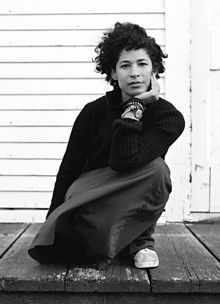
Back الموجة النسوية الثالثة Arabic তৃতীয় ঢৌৰ নাৰীবাদ Assamese Feminizmin üçüncü dalğası Azerbaijani Трэцяя хваля фемінізму Byelorussian Трета вълна на феминизма Bulgarian নারীবাদের তৃতীয় তরঙ্গ Bengali/Bangla Tercera onada de teoria feminista Catalan Tredje bølge af feminisme Danish Feminismus#Dritte Welle German Τρίτο Κύμα Φεμινισμού Greek
| Part of a series on |
| Feminism |
|---|
 |
|
|

Third-wave feminism is a feminist movement that began in the early 1990s,[2] prominent in the decades prior to the fourth wave.[3][4] Grounded in the civil-rights advances of the second wave, Gen X third-wave feminists born in the 1960s and 1970s embraced diversity and individualism in women, and sought to redefine what it meant to be a feminist.[2][5][6] The third wave saw the emergence of new feminist currents and theories, such as intersectionality, sex positivity, vegetarian ecofeminism, transfeminism, and postmodern feminism. According to feminist scholar Elizabeth Evans, the "confusion surrounding what constitutes third-wave feminism is in some respects its defining feature."[7]
The third wave is traced to Anita Hill's televised testimony in 1991 to an all-male all-white Senate Judiciary Committee that the judge Clarence Thomas had sexually harassed her. The term third wave is credited to Rebecca Walker, who responded to Thomas's appointment to the Supreme Court with an article in Ms. magazine, "Becoming the Third Wave" (1992).[8][1][6] She wrote:
So I write this as a plea to all women, especially women of my generation: Let Thomas' confirmation serve to remind you, as it did me, that the fight is far from over. Let this dismissal of a woman's experience move you to anger. Turn that outrage into political power. Do not vote for them unless they work for us. Do not have sex with them, do not break bread with them, do not nurture them if they don't prioritize our freedom to control our bodies and our lives. I am not a post-feminism feminist. I am the Third Wave.[9][1]
Walker sought to establish that third-wave feminism was not just a reaction but a movement in itself because the feminist cause had more work ahead. The term intersectionality to describe the idea that women experience "layers of oppression" caused, for example, by gender, race, and class had been introduced by Kimberlé Crenshaw in 1989, and it was during the third wave that the concept flourished.[10]
In addition, third-wave feminism is traced to the emergence of the riot grrrl feminist punk subculture in Olympia, Washington, in the early 1990s.[a] As feminists came online in the late 1990s and early 2000s and reached a global audience with blogs and e-zines, they broadened their goals, focusing on abolishing gender-role stereotypes and expanding feminism to include women with diverse racial and cultural identities.[12][13]
- ^ a b c Walker, Rebecca (January 1992). "Becoming the Third Wave" (PDF). Ms.: 39–41. ISSN 0047-8318. OCLC 194419734. Archived (PDF) from the original on 2017-01-15. Retrieved 2016-10-13.
- ^ a b Evans 2015, 22.
- ^ Rivers, Nicola (2017). Postfeminism(s) and the Arrival of the Fourth Wave. Palgrave Macmillan. 8.
- ^ Cochrane, Kira (10 December 2013). "The Fourth Wave of Feminism: Meet the Rebel Women". The Guardian. Archived from the original on 14 March 2016. Retrieved 2 June 2019.
- ^ "The Third Wave of Feminism" Archived 2019-05-28 at the Wayback Machine, Encyclopaedia Britannica.
- ^ a b Baumgardner & Richards 2000, p. 77
- ^ Evans 2015, 49.
- ^ "Becoming the Third Wave" by Rebecca Walker
- ^ "Becoming the Third Wave" by Rebecca Walker
- ^ Evans 2015, 19.
- ^ Feliciano, Steve (19 June 2013). "The Riot Grrrl Movement". New York Public Library. Archived from the original on 3 April 2019. Retrieved 2 June 2019.
- ^ Cite error: The named reference
Brunell2008was invoked but never defined (see the help page). - ^ Tong, Rosemarie (2009). Feminist Thought: A More Comprehensive Introduction (Third ed.). Boulder, CO: Westview Press. pp. 284–285, 289. ISBN 978-0-8133-4375-4. OCLC 156811918.
Cite error: There are <ref group=lower-alpha> tags or {{efn}} templates on this page, but the references will not show without a {{reflist|group=lower-alpha}} template or {{notelist}} template (see the help page).